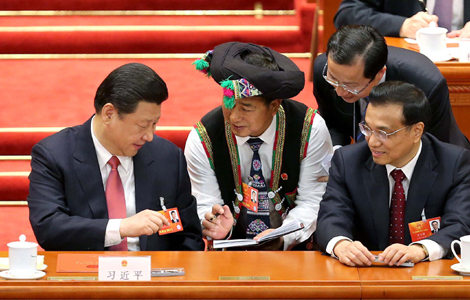Advantage of upgrading
Even though its demographic dividend is coming to an end, China should not undervalue its manufacturing
Recent statistics published by the National Bureau of Statistics indicate that China's working-age population decreased by 3.45 million during 2012. This was the first decline in decades, and it has caused widespread concern that the country's demographic dividend is coming to an end.
The end of the country's decades-long demographic dividend will undoubtedly have enormous repercussions for China's manufacturing sector, whose incredible achievements can be largely attributed to the huge cost advantages it has gained from low-paid labor.
However, given that the demographic advantage has never been the only driving force for the country's economic growth, the declining demographic advantage does not inevitably mean the end of China's incredible manufacturing growth. China can take the ending of the demographic dividend as a new opportunity to promote industrial upgrading, such as changing the sector's deep-rooted GDP-prioritized growth model, easing its structural contradictions and raising the added value of its products.
Given China's manufacturers are highly concentrated in the eastern regions, blindly increasing manufacturing inputs in these saturated areas will cause labor costs to rise and increase the pressures on smaller enterprises to an unbearable level, leading to a growing number of bankruptcies. So China should accelerate the transfer of its manufacturing from the coastal to inland regions.
The less-developed central and western regions still have a huge demand for manufacturing and their abundant supply of labor has created favorable conditions for a westward industrial shift. The latest data from the National Bureau of Statistics indicated that in 2011, 57.3 percent of China's 158.63 million migrant workers came from its central and western regions. The sixth National Census conducted in 2010 indicated that China's population growth is 0.678 percent in its western regions, much higher than the 0.468 percent in eastern regions. The higher population growth rate in the western areas means they can accommodate expanded manufacturing activities.
These, together with their lower consumption level, land prices and wages, mean China's western regions still offer manufacturers cost advantages, so relocating some east-coast manufacturing to these regions will help ease the labor shortages occurring in the eastern regions and increase the domestic demand for consumer goods.
China's manufacturing sector urgently needs to find new markets and to undertake technological upgrading, as it faces not just the challenge of rising production costs. There is now also fiercer competition from the United States as a result of its re-industrialization strategy and the emergence of manufacturing in some Southeast Asian nations.
The higher quality urbanization, as conceptualized by the country's new leaders, will thus help bolster the development of China's manufacturing sector. The ruling party's new leadership has highlighted that urbanization will be the main driver of China's economic growth in the future and the country will seek to convert migrant workers to urban residents. With accelerated efforts to push forward urbanization more surplus rural labor will migrate to the cities, which will also help ease the labor shortage caused by the disappearance of China's demographic dividend. The official urbanization ratio is about 51 percent at present, but if the migrant workers who have settled in cities yet failed to gain an urban household registration are taken into account, some experts estimate the urbanization ratio is lower than the official level and much less than that of developed countries where the urbanization ratio is more than 70 percent.
It is estimated that China's urbanization ratio will rise by 1 percentage point a year over the next 20 years. Such an urbanization boom will forcibly boost the country's domestic demand, as the consumption of urban residents is three times that of rural residents. The increased consumption resulting from a raised urbanization ratio will undoubtedly help change long-running imbalances in China's economic structure.
Meanwhile, upgrading should be the focus of efforts to transform the sprawling manufacturing sector. Even if some manufacturers are able to raise their added value and acquire a higher position in the global value chain, ignoring the country's concrete conditions while pursuing higher added value or innovations could cause the de-industrialization of the national economy.
The decline and final disappearance of China's demographic dividend will unavoidably sap the country's comparative advantage, but its manufacturing will still be an important part of the global economic system if efforts are made to improve the quality of the "made-in-China" brand.
However, China should be aware that it is unrealistic and impractical to demand all its shoe producers to manufacture high-tech products. Instead, it should try to improve their manufacturing technology and craftsmanship as a way of improving their product quality and increasing their added value.
Aided by the establishment of a more comprehensive industrial chain and a well-developed industrial system, made-in-China can be transformed into "created-in-China" if systematic reforms are conducted. Enterprises are the main driver of innovation, so the government should provide necessary institutional support to enterprises and allow them to take the lead in innovation. It is also necessary to overcome any vested interests that stand in the way of advancing the nation's manufacturing.
China should not undervalue the development of its labor-intensive manufacturing sector while accelerating efforts to pursue high technologies and the development of its financial sector. Its manufacturing has been the largest factor underlying China's phenomenal economic growth and has been the largest source of jobs since the launch of reform and opening-up more than 30 years ago.
The author is a professor with the Beijing University of Science and Technology.
(China Daily 03/05/2013 page9)


